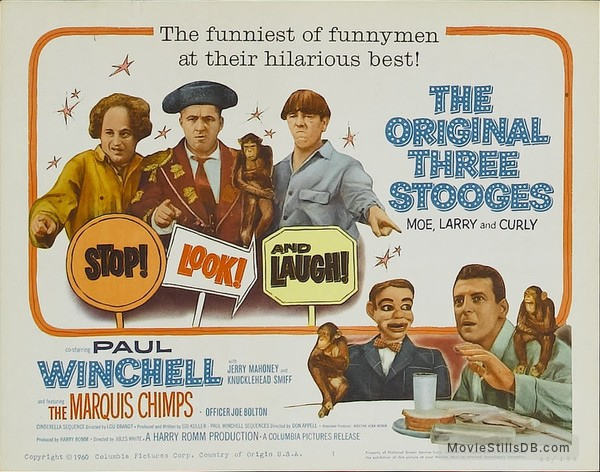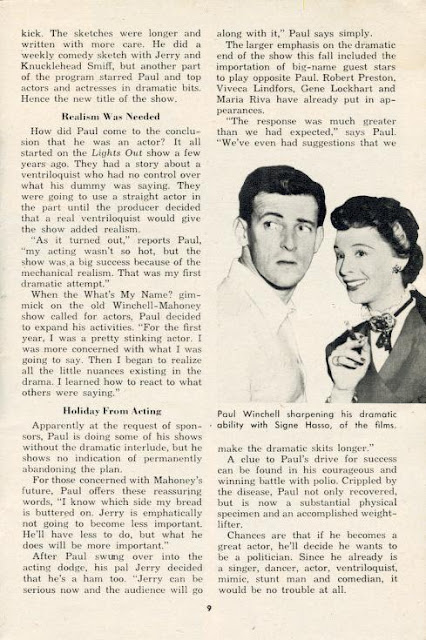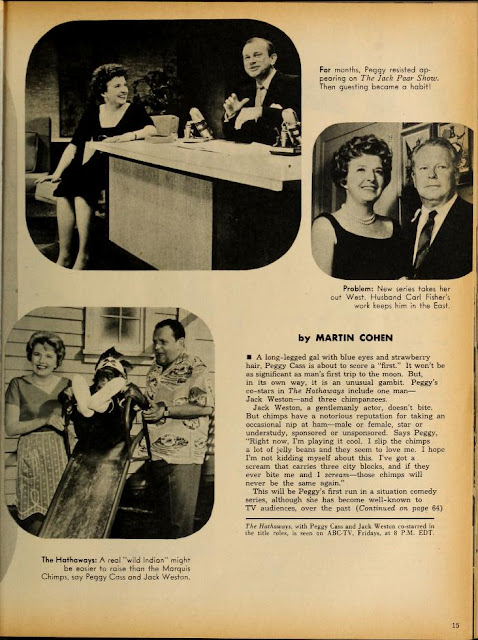
After the box office success of Have Rocket Will Travel (1959), that movie's producer Harry Romm quickly wanted to make another feature film starring The Three Stooges. However, since The Stooges were experiencing a major resurgence in popularity, they felt comfortable in asking for 75% of the profits. While Romm wanted to make a new Stooge feature film, he still wanted his usual 50% of the profits. Stop! Look! and Laugh! was his way of having his cake and eating it too. By going directly to Columbia, Romm took footage from old Stooge short films and connected them together with new footage that didn't feature the Stooges.
The new footage would star ventriloquist Paul Winchell and his dummies, Jerry Mahoney and Knucklehead Smiff. Paul Winchell had briefly had a radio show in 1943, but the show did not last long, and its popularity was clearly overshadowed by Edgar Bergan's show. However by the time this film was made, Winchell was best known for his children's TV show, The Paul Winchell and Jerry Mahoney Show (1950-1956). This show would feature a lot of corny comedy with him and Jerry Mahoney and Knucklehead Smiff, as well as a lot of advertising for the show's sponsor, Tootsie Roll. This show has an important place in TV history as it featured the TV debut of Carol Burnett. Today however Paul Winchell will mainly be remembered by animation buffs for his voice work on Hanna-Barbera's TV cartoons. He voiced the villainous Dick Dastardly (Wacky Races (1968-1970) and Dastardly and Muttley in their Flying Machines (1969-1970)) and the evil Gargamel (The Smurfs (1981-1989)). Disney fans will best know him as the original voice of Tigger for the Disney Winnie the Pooh films. Stop! Look! and Laugh! was not Winchell's only Three Stooges connection. He had voiced Moe in The Three Stooges episodes of The New Scooby-Doo! Movies (1972-1973) and the TV cartoon, The Robotic Stooges (1978).

TV Guide, 1954
This movie also features The Marquis Chimps, these were a trio of comedic chimps owned and trained by Gene Detroy. Detroy was born into a family of circus performers. In the late 1940's he began raising and training chimps, which he would do for 30 years. In the early years of him raising chimps, one of his chimps was named Marquis. Because of this someone suggested he call the act, The Marquis Chimps. Detroy liked this idea and the name stuck. Starting in the mid-1950's, the chimps started appearing on TV shows. Over their career the chimps made appearances on such shows as The Colgate Comedy Hour (1950-1955), The Ed Sullivan Show (1948-1971), The Jack Benny Program (1950-1965) and The Lucy Show (1962-1968). The Marquis Chimps also starred in their own TV show, The Hathaways (1961-1962). This was a typical sitcom about the typical American family, a husband, a wife and their three chimps. Stop! Look! and Laugh! is one of the only two feature films that The Marquis Chimps appeared in. The other is a delightful live action Disney movie, Toby Tyler or Ten Weeks with a Circus (1960). In Stop! Look! and Laugh!, the chimps perform their own version of the classic fairytale Cinderella. Since chimps don't talk, the voices were provided by real life people. One voice in this section of the film will sound quite familiar to many cartoon fans. This voice is the one and only June Foray. June Foray is a voice acting legend and is best remembered today for providing many female voices for Looney Tunes and Merrie Melodies (including Granny), as well as being the voice of TV's Rocky the flying squirrel.

Radio TV Mirror, 1961.
This movie doesn't have much in the way of an actual story. This is just an average day in the life of Paul Winchell and his dummies, mostly told through a series of brief comedy skits that are designed to transition to the next clip of The Stooges.
I must say the clips of The Three Stooges used here are fantastic. This may at first seem like an obvious e statement, but it really isn't. Too many of these feature length compilations of a comedian's or group of comedians' work fail to show them at their best and instead just show random clips from their career instead. This movie though actual shows The Stooges at their best and therefore there will be plenty of real laughs for any Stooge fans who watch this film. The clips all come from the Curly era of the Stooges output. Though many Stooge fans have divisive feelings about some eras in The Stooges' history (especially the Joe and Curly Joe eras), pretty much every Stooge fan agrees that the Curly era is where some of the boy's best work came from. Not only does this movie show clips of the Stooges in their prime, but it shows some of the funniest moments from this era. The shorts used here include How High is Up (1940, directed by Del Lord), Violent is the Word for Curly (1938, directed by Charley Chase), Sock a Bye Baby (1942, directed by Jules White), Higher Than a Kite (1943, directed by Del Lord), What's the Matador? (1942, directed by Jules White), Calling All Curs (1939, directed by Jules White), Goofs and Saddles (1937, directed by Del Lord), Micro-Phonies (1945, directed by Edward Bernds), A Pluming We Will Go (1940, directed by Del Lord) and Half Wits Holiday (1947, directed by Jules White and featuring Curly's last starring appearance with The Stooges). As a Stooge fan, I certainly can't argue with a line up like that. It even includes Curly's personal favorite Stooge short, A Plumbing We Will Go. While I would recommend anyone new to the Stooges starts with the classic Stooge shorts in their entirety, I can see someone new to the Stooges becoming a fan after seeing this movie with how good the clips are.
The Paul Winchell skits may not be masterpieces, but they work well enough. While the original Stooge shorts were aimed at all ages, these Paul Winchell shorts are clearly aimed at kids. Because of this adult movie fans will probably not laugh at these skits as much as the clips from the Stooges shorts. Still there is nothing truly bad about these skits and taken as children's entertainment they are pretty good actually. I will admit I even got a few chuckles from a couple of these skits. So, while I understand why some Stooge fans will find the inclusion of these skits, I personally find them charming for what they are.
Now the Marquis Chimps version of Cinderella on the other hand is quite bad. I can't even see myself as a little kid enjoying this. And you know a skit is bad when even June Foray can't save it. The main problem is that this scene doesn't have any real jokes. The filmmakers just simply think the idea that we are seeing Cinderella performed by monkeys is funny enough on its own. In reality it isn't even slightly amusing. I really wish that instead of this sequence the movie including more Three Stooges clips, but this skit is the price you will have to face for watching an otherwise fun movie.
James B. Meyers Jr. of the Bluebird Theatre in Petersburg, Virgina went all out when this movie played at his theater.
"Playing the double bill of Columbia's 'My Dog Buddy' and 'Stop! Look! and Laugh!' recently in our 473-seat house we tried our hand at some selling that was well within our small budget.
"An idea occurred to me that might help the sales of concessions while at the same time tying in with one of the features. Accordingly I made up three octagon shapes for each left hand door entering the orchestra. The top sign was lettered STOP. This was on red cardboard. The second sign was lettered LOOK and this was on white cardboard, while the third sign was lettered AND LAUGH and was on blue cardboard. On the right hand doors, another sign was lettered 'DO NOT ENTER.' This was opposite the red sign. Another read 'UNTIL YOU HAVE LOOKED OVER OUR FINE ASSORTMANT OF CANDIES AND TASTED OUR DELICIOUS HOT BUTTERED POPCORN.' Opposite the blue sign another was lettered 'NOW ENTER! AND LAUGH TO YOUR HEARTS CONTENT WITH THE THREE STOOGES IN STOP, LOOK AND LAUGH.'
"Being mindful of the fact that nearly every person will observe a stop sign, it was no surprise to me that everyone DID stop and read this display from top to bottom before entering the orchestra. I might add that our concession stand is located exactly in the center of the two sets of lobby doors.
"The art work was done by myself with the cost of the signs $1.97 for the cardboard and 35 cents for a magic marker.
"To promote interest in the other feature, 'My Dog Buddy' and also to get some outside advertising away from the theatre I enlisted the services of a young lad who owned a German shepherd dog, with his parents' permission to walk around town in the main business section. A small sign was placed on either side of the small dog, lettered 'Don't miss 'My Dog Buddy,' Now Showing Bluebird.' The local boy and his dog resembled the boy and the dog starring in the picture. This little stunt attracted a lot of street attention. This cost me a trifle over $5."
The Stooges themselves were not very amused with the idea of this movie and sued Harry Romm and Columbia over the picture feeling that it was illegal to use their comedies without their permission. This ended up being settled out of court. The Stooges received a cash settlement and a contract to make another feature film for $50,000. Though they would receive 50 percent of the profits, Moe's son in law and the team's manager (as well as writer of The Three Stooges comic books) Norman Maurer would become the film's producer.
Resources Used
The Three Stooges Scrapbook by Jeff Lenburg, Jean Howard Maurer and Greg Lenburg.
https://mediahistoryproject.org/
https://www.paulwinchell.com/bio.html
https://books.google.co.uk/books?id=VKS1-aBvXawC&pg=PT170&lpg=PT170&dq=The+Marquis+Chimps+were+owned+and+shown+by+Gene+Detroy&source=bl&ots=0jV-nXjXW7&sig=ACfU3U3eZ2E6E-iwLoqE-0vENMDYd3RgoA&hl=en&sa=X&ved=2ahUKEwim2OjXkv7sAhXAQUEAHYj8CeI4FBDoATADegQIAhAC#v=onepage&q=Marquis%20Chimps&f=false
https://www.imdb.com/?ref_=nv_home




No comments:
Post a Comment